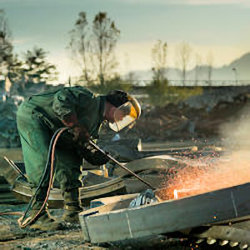Protection from Respiratory Hazards
Protect yourself and your co-workers from respiratory hazards by doing the following:

- Identify the respiratory hazards in your workplace.
- Evaluate employees' exposures to each hazard.
- Use the evaluation information to eliminate the hazards or to lower employees' exposures to safe levels.
This three-step process, summarized below, is called a hazard analysis or hazard evaluation.
Identifying Respiratory Hazards
To identify air contaminants that may be hazardous, conduct observations, inspections, and interviews. These methods help to identify the sources of respiratory hazards such as production processes, work tasks, raw materials, and final products.
- Observations conducted during the workday can be effective if employees take the time to observe conditions and work over time.
- Inspections are effective in detecting hazardous conditions, but not as effective in uncovering unsafe behaviors.
- Interviews can be quite effective in gathering information if employees are asked open-ended "who, what, where, how, and when" questions.
- Who is most likely to be exposed to air contaminants?
- What raw materials are used in a production process?
- What are the intermediate products and the byproducts of each process?
- What equipment or substances used by employees might create unacceptable levels of exposure?
- What are the safety or health concerns employees have about certain products, materials, or machines?
- Where do air contaminants exist in the workplace?
- How may air contaminants affect productivity in the workplace?
- When are air contaminants most noticeable during the workday?
- When have employees experienced and/or reported signs or symptoms of respiratory conditions?
Knowledge Check Choose the best answer for the question.
1-2. Which process is effective in detecting hazardous conditions, but not as effective in uncovering unsafe behaviors?
You forgot to answer the question!
